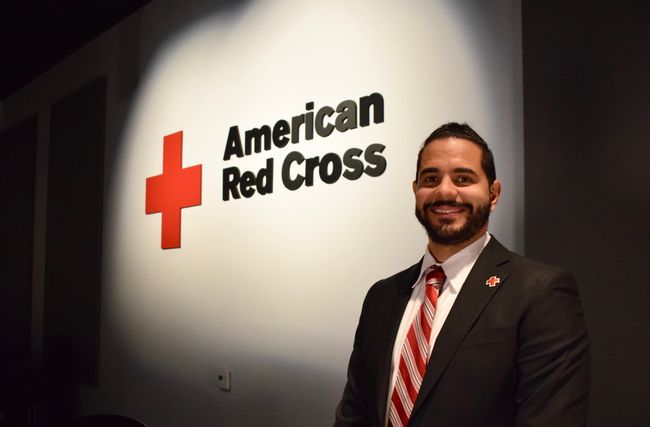Alexis Agrinsoni (‘15)
As a disaster relief manager for the American Red Cross, Alexis Agrinsoni (BRIDGE‘15) empowers vulnerable communities

Alexis Agrinsoni (‘15) and his undergraduate college roommates made a pact: as men of color, they would each commit to pursuing a master’s degree in social work (MSW) to become empowered agents of change for vulnerable communities.
“As men of color, we would challenge each other and ask ourselves how we could improve our lives,” recalls Agrinsoni, who is Latino. “We decided furthering our education would help us become role models in our own communities.”
Agrinsoni grew up in a poor, inner-city Boston neighborhood, where he says positive male role models were scarce and being a gang member or dealing drugs was more popular than doing well in school. So his mother enrolled him in the METCO (Metropolitan Council for Educational Opportunity) program to provide him with an opportunity to attend a high-performing school outside the city in Westwood, Mass.
“The METCO program opened my eyes because there, my peers’ motivation was education,” Agrinsoni says. “For me to be a cool kid, I had to make sure I had good grades and made education a priority.”
When he returned home each day, however, he wasn’t quite as cool. In fact he was harassed for “trying to be white.” But instead of shutting down, Agrinsoni realized that he would need more than a high school diploma to ‘be the change’ he wanted to see in his community. “I knew if I wanted to stay alive and survive, I had to do something different than some of my friends.”
So he did. After high school, Agrinsoni earned a bachelor’s degree in psychology at Becker College and provided substance use counseling and treatment for adolescents at Community Healthlink in Worcester, Massachusetts. There, he recognized the need for more men of color in the field of social work and decided to follow through on the pact he and his friends made to get an MSW. After returning to his Boston neighborhood for a program coordinator job at Hyde Square Task Force in 2011, he applied to the Building Refugee and Immigrant Degrees for Graduate Education (BRIDGE) program at Boston University’s School of Social Work (BUSSW), where sociology professor and director of BRIDGE Lee Staples became his mentor.
“Lee and BRIDGE helped me start my journey,” Agrinsoni recalls as he describes how he gained a better understanding of the BUSSW MSW program, plus the wide range of career opportunities available in social work. “Lee brought in great speakers and many alumni — including men of color — with interesting jobs. It helped me realize how much of an asset I could be to minority clients.”
That sense of identification and relatability to clients is something Agrinsoni had to find on his own as a teenager. “I was a Latino kid from the city going to a school in the suburbs with mostly white students. Sometimes I wouldn’t fit in because I didn’t look like my peers, and when I got home to my neighborhood, I was sometimes left out for being focused on academics.”
It was a challenge, but also a transformative experience that taught Agrinsoni to carve out his own character and advocate for himself — something that the BRIDGE program emphasized early on. “I learned that if I’m going to advocate for others, I have to first know how to advocate for myself.”
Agrinsoni also learned how to manage the graduate school application process, which was important as he was a first-generation college student. Simply put, he says that BRIDGE was just that: a bridge to eventually understanding that he truly wanted a career in social work and a degree from BUSSW.
It was during the BRIDGE program that Agrinsoni developed an interest in macro-level social work. “Initially, I thought I wanted to be a clinical therapist until I learned more about planning and policies. Once I decided to pursue a macro major, I chose BU because a lot of other schools didn’t emphasize that option.”
He says that material from graduate courses he took, such as public policy and community engagement, is directly relevant to his current role as a regional disaster relief manager for the American Red Cross in Los Angeles, where he oversees recovery efforts.
Artful listening is also a major component of his job. “After a disaster, a lot of people are heartbroken and devastated because they have lost everything,” Agrinsoni says. “When I walk into a shelter or evacuation center and listen to their stories, I let people know that someone cares. I will do anything and everything I can to help them develop a recovery plan. My goal is to leave people better than how I found them.”
Learn more about the BRIDGE Program here or support the Bridge Program by visiting this link.